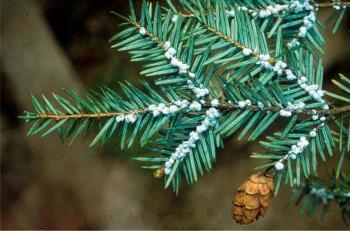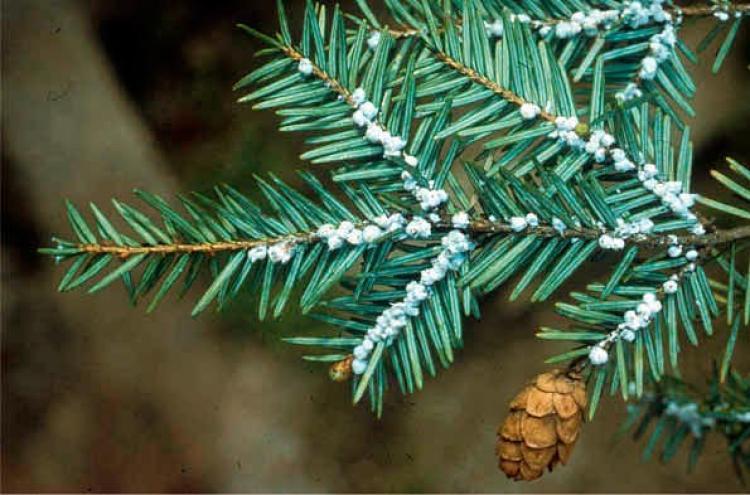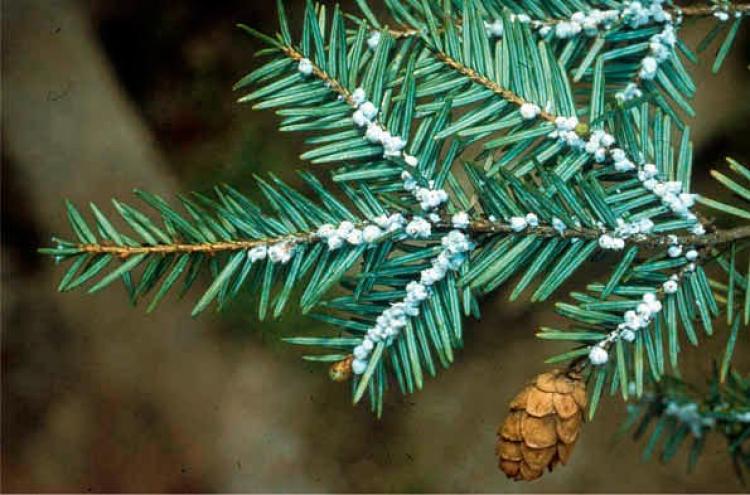Maine Government News recently announced that a “light touch” of hemlock woolly adelgid (HWA) was discovered at Vaughan Woods State Park in South Berwick. HWA has in fact become a major predator of both eastern (Canadian) and Carolina hemlock trees. The infestations impact as much as 50 percent of the geographic range of hemlock in 18 states, from northeastern Georgia to southeastern Maine, and as far west as eastern Kentucky, and Tennessee.
Hemlock woolly adelgid is a small aphid-like insect with a white, waxy wool-like covering material on its body. Its presence can be identified by small cottony egg sacs that cling to the underside of twigs at the base of the needles. It reproduces asexually, and can produce two generations per year, with 100-300 eggs contained in the woolly egg sacs.
Larvae emerging in the spring are tiny and light, and can easily be carried by wind, birds and/or mammals. The adelgid feeds on the sap of tender hemlock shoots and injects a toxin into it while feeding. This causes needle loss, discoloration, crown thinning, and dieback, and the eventual death of the tree within 4-10 years.
HWA was first described in western North America in 1924, and first reported in the eastern United States in 1951. Research scientists have determined that HWA in the East originated from southern Japan. HWA caused little damage to hemlocks in Japan, and it is believed that resistances have evolved to combat infestation.
The hemlock is the third-most prevalent tree in Vermont, and a significant species in other New England states.
Hemlocks are usually found near bodies of water. Besides being a significant contribution to annual lumber harvests, its most significant impact—deemed irreplaceable—is its contribution to environmental and wildlife ecology. It has a particular quality to it that protects from forest floor erosion. The tree’s low, sweeping branches have the capacity to moderate and buffer winter temperatures and subsequently protect brook trout. It also provides important winter shelter areas for deer and other animals.
To battle HWA, the Maine Forestry Service has adopted four remedial approaches to combat the insect: regular surveying and monitoring to help prevent the spread of HWA; chemical control by spraying in high-traffic areas, such as roadsides and residential sites that can reduce accidental human spreading; and the experimental release of two species of beetle, which feed exclusively on adelgid.
The fourth approach is public outreach, with the understanding that an informed public plays an important role in detecting and helping stop the spread of HWA.
The forestry service believes that the best hope for long-term control of HWA is biological control in Maine’s forests, and many states are following similar approaches.
Hemlock woolly adelgid is a small aphid-like insect with a white, waxy wool-like covering material on its body. Its presence can be identified by small cottony egg sacs that cling to the underside of twigs at the base of the needles. It reproduces asexually, and can produce two generations per year, with 100-300 eggs contained in the woolly egg sacs.
Larvae emerging in the spring are tiny and light, and can easily be carried by wind, birds and/or mammals. The adelgid feeds on the sap of tender hemlock shoots and injects a toxin into it while feeding. This causes needle loss, discoloration, crown thinning, and dieback, and the eventual death of the tree within 4-10 years.
HWA was first described in western North America in 1924, and first reported in the eastern United States in 1951. Research scientists have determined that HWA in the East originated from southern Japan. HWA caused little damage to hemlocks in Japan, and it is believed that resistances have evolved to combat infestation.
The hemlock is the third-most prevalent tree in Vermont, and a significant species in other New England states.
Hemlocks are usually found near bodies of water. Besides being a significant contribution to annual lumber harvests, its most significant impact—deemed irreplaceable—is its contribution to environmental and wildlife ecology. It has a particular quality to it that protects from forest floor erosion. The tree’s low, sweeping branches have the capacity to moderate and buffer winter temperatures and subsequently protect brook trout. It also provides important winter shelter areas for deer and other animals.
To battle HWA, the Maine Forestry Service has adopted four remedial approaches to combat the insect: regular surveying and monitoring to help prevent the spread of HWA; chemical control by spraying in high-traffic areas, such as roadsides and residential sites that can reduce accidental human spreading; and the experimental release of two species of beetle, which feed exclusively on adelgid.
The fourth approach is public outreach, with the understanding that an informed public plays an important role in detecting and helping stop the spread of HWA.
The forestry service believes that the best hope for long-term control of HWA is biological control in Maine’s forests, and many states are following similar approaches.





